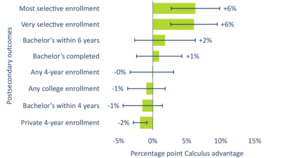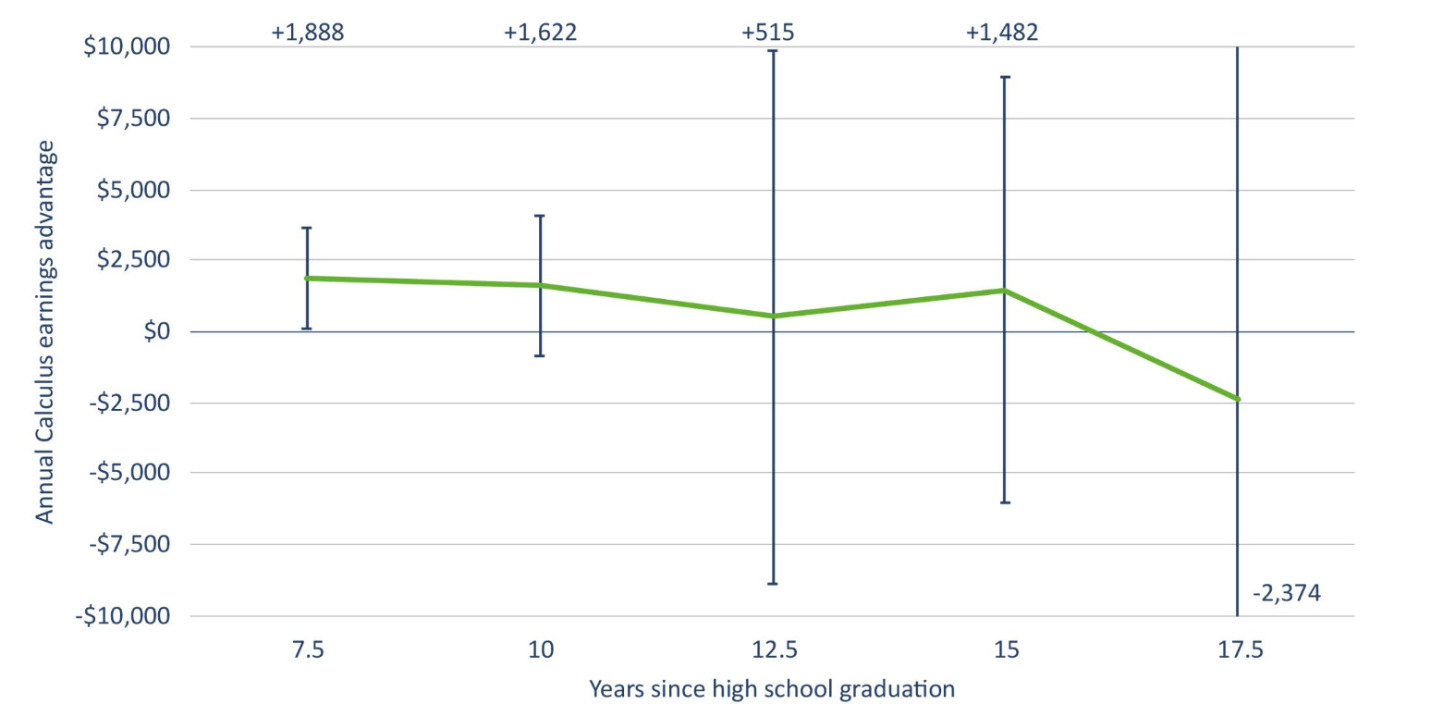Calculus has long been the primary gateway course for advanced math students in Oklahoma and across the nation. While students who take calculus and other advanced math courses tend to show strong academic and career outcomes, it is a matter of debate whether these patterns reflect a direct effect of calculus-taking or the fact that higher-performing students – and those with their sights set on elite universities – tend to take the course. Calculus certainly seems to align well with the ambitions of students who decide to pursue STEM degrees in college, but a growing movement to expand the definition of advanced high school mathematics has prompted questions about mathematical rigor, equity in course access, and the utility of calculus for non-STEM students.
Access to calculus and other advanced math courses remains deeply uneven, especially in rural states such as Oklahoma. Students in small towns and rural areas, who make up a large share of the state’s high school population, often have less access to advanced math courses because of teacher shortages, small enrollments, and limited course offerings. Some rural high schools also offer no Advanced Placement (AP) courses at all, let alone AP Calculus or AP Statistics, closing off pathways to college-level math. In cities and suburbs, too, disparities in AP and other advanced course access persist across high schools.
Advanced math alternatives to the calculus pathway, which include statistics as well as other courses such as data science, not only can help students build high-demand skills in today’s data-driven economy, but also may expand access to advanced math. Recent research indicates that students who pursue rigorous alternatives to high school calculus fare just as well on many postsecondary outcomes as calculus-takers. If implemented thoughtfully, elevating statistics and data science as calculus alternatives could help more Oklahoma students connect advanced math to their future studies and careers.
To explore this issue, we examine the availability of AP Calculus and AP Statistics in Oklahoma high schools over the past fifteen years. Our analysis finds that while calculus offerings have declined, statistics courses have expanded modestly, suggesting a slow but measurable diversification of advanced math pathways. The results point to both the challenges and opportunities facing Oklahoma as it seeks to modernize its math landscape and ensure that all students can pursue advanced, high-quality coursework aligned with their interests and goals.
Is Calculus Overrated?
For some students, calculus represents the pinnacle of high school mathematics and a gateway to selective colleges and lucrative STEM careers. From this perspective, reducing its prominence could result in lower academic standards and diminished opportunities for students who might otherwise pursue advanced math in college. Others, however, argue that calculus often functions much like Latin did in earlier eras: a symbolic marker of elite academic status rather than a practical skill set that most students will put to use in their adult lives. Although only a small share of students take calculus in high school, many more take Algebra II and Precalculus largely as preparation for it, even at the expense of alternative courses that might better match their interests and career aspirations.
Contrast that with statistical reasoning and data analysis, subjects that have become increasingly relevant in our data-driven economy. Research shows that across industries, including in business, healthcare, manufacturing, or public service, workers rely far more on statistics and data interpretation than on calculus. Reflecting this reality, AP Statistics has been among the fastest-growing math courses in the country for the past two decades, and that course is viewed by many educators as both rigorous and useful. At the same time, several states have begun to diversify their high school math pathways. Reforms in places like California, Rhode Island, and Ohio have introduced new data science or statistics options, revised graduation requirements, or adjusted state university admissions criteria to align high school math with real-world applications.
California’s reforms provide a cautionary tale. In 2017, the Golden State began allowing students to substitute a new data science course for Algebra II in the state’s higher education admissions system. But in 2024, California had to reverse course because, as the chair of the University of California Board of Admissions and Relations with Schools, put it, “Data Science is not well-defined.” Nonetheless, alternatives to the calculus pathway that are underpinned by strong standards, curricula, and assessments can be rigorous. A recent study co-authored by one of the present article’s authors and using two decades of Texas student-level data provides the first comprehensive evidence comparing AP Calculus AB and AP Statistics students. The study finds that calculus and statistics students have equivalent rates of college enrollment and bachelor’s degree completion after adjusting for prior achievement and other factors; the main systematic postsecondary difference is that Calculus AB students are more likely to enroll in very selective institutions, while AP Statistics students are modestly more likely to enroll in private four-year colleges (see Figure 1 below).
However, calculus does have a notable advantage for STEM students: AP Calculus AB students are about 11 percentage points more likely to declare a STEM major than observably similar AP Statistics students. This “STEM advantage” does not translate into a durable labor-market premium over statistics. In Texas, AP Calculus AB students earned slightly more income in their careers 7.5–10 years after graduation, but these differences eventually faded away and were statistically indistinguishable by 17.5 years (see Figure 2 below). Although calculus likely steers students towards STEM, it does not yield higher long-run earnings than statistics for comparable students.
AP Calculus and AP Statistics Availability in Oklahoma’s Public High Schools
While the findings from Texas provide new insight into the calculus-versus-statistics debate nationally, the larger challenge for Oklahoma is that many students never have the opportunity to take either course. Advanced math courses are a vital part of the STEM worker pipeline, but in Oklahoma, large numbers of high schoolers lack the opportunity to take AP math courses. Indeed, about half of the state’s high schools offered no AP courses whatsoever during the 2023-24 academic year, with access especially limited in rural areas. Schools in rural communities face barriers, such as teacher shortages and small enrollments, that make offering advanced math difficult. The Education Commission of the States reports that rural school districts nationwide struggle to hire and retain qualified AP teachers, resulting in lower course access and exam-taking rates than their urban and suburban counterparts, a challenge Oklahoma exemplifies. The result shows a troubling pattern: students in small towns and rural areas often attend schools that simply do not offer the kinds of advanced math courses that can open doors to competitive college programs and high-demand career fields.
These disparities matter because they can shape students’ academic and economic futures. As other states modernize their math pathways and expand opportunities in statistics and data science, Oklahoma’s students, especially those residing in rural areas and small towns, may find themselves further disadvantaged if similar reforms do not reach them.
To analyze trends in AP math course availability, including for AP Calculus (both AB and BC) and AP Statistics, we manually compiled publicly available data from the College Board’s AP Course Ledger and the National Center for Education Statistics’ Elementary and Secondary Information System (ELSi). We included data from all public high schools in Oklahoma during the years 2007-08, 2012-13, 2017-18, and the post-pandemic year of 2022-23.
In general, AP course availability in Oklahoma was stagnant from 2007-08 to 2022-23, although there were some differences by subject (Figure 3). In 2007-08, over a quarter (29 percent) of the state’s 470 public high schools offered AP Calculus AB to their students. The share of high schools offering AP Calculus AB then declined to 20 percent of the state’s high schools in 2017-18 before increasing very slightly to 22 percent of high schools in 2022-23. The proportion of high schools offering AP Calculus BC, the more advanced AP calculus course, was essentially flat during this entire period, around 6 percent. In contrast, the share of Oklahoma high schools offering AP Statistics increased slightly during this period. In 2008, just 8 percent of high schools offered the course, but that share rose to 10 percent by 2022-23.
Diverse High School Math Pathways in Oklahoma
In recent years, some efforts have been made to ensure greater accessibility of advanced coursework in Oklahoma public high schools. The passage of House Bill 3400, for example, required the state’s public high schools to offer a minimum of four AP courses. Such courses could be offered either at district school sites, a career and technology institution within a specific district, or through online learning platforms. Yet media reports suggest that most high schools in the state are out of compliance, underscoring the gap between policy intent and classroom reality. The problem is even worse in rural areas, where a lack of teacher capacity and student demand constrain schools’ ability to offer AP courses, in general. As our analysis of AP math course offerings shows, AP Calculus offerings have actually fallen in recent years.
Our findings – and Oklahoma’s access challenges – suggest that the future of advanced math should not be an either-or debate between calculus and statistics. Instead, schools should preserve robust calculus routes for STEM-bound students while building equally rigorous statistics and data-science pathways for all learners. The question for Oklahoma is how to expand options without sacrificing rigor or widening gaps, especially in rural communities. Based on my empirical work in this area, I offer three considerations for school leaders
First, a non-calculus data science pathway can be rigorous and effective, but only with strong standards, curricula, and assessments. Statistics and data-rich coursework are increasingly relevant for Oklahoma’s economy, including the energy, aerospace/defense, finance/insurance services, health care, and ag-tech sectors. Yet “alternative” pathways can drift into low-expectations tracks if content is vague or accountability is weak. Non-calculus pathways, including alternatives to calculus as well as its prerequisites, will be strongest when they follow the recipe of the AP program: transparent standards, high-quality curricula, and external assessments.
Second, recognize that diversified pathways alone will not close equity gaps. Oklahoma should work to widen the pipeline earlier and remove barriers that suppress uptake. Policies such as auto-enrollment of high-scoring math students into the advanced algebra track in middle school, a policy that has gained traction in several states recently, may help widen the pipeline of high achievers.
Third, calculus should remain a priority for STEM-bound students while statistics/data science should be elevated as a first-class capstone. AP Calculus steers more students toward STEM majors; that matters for Oklahoma’s engineering, energy, and aerospace workforce. At the same time, long-run earnings for observably similar Calculus AB and AP Statistics students converge, and statistics skills map directly onto Oklahoma industries beyond traditional STEM subjects. Ultimately, the goal should be to make rigorous math universal, not exclusive. This will help to ensure that every student in Oklahoma, regardless of ZIP code, can pursue the pathway that fits their ambitions.
Author Bios
Adam Tyner is Executive Director of the Oklahoma Center for Education Policy.
Robert Chung is a research intern at the Thomas B. Fordham Institute.










